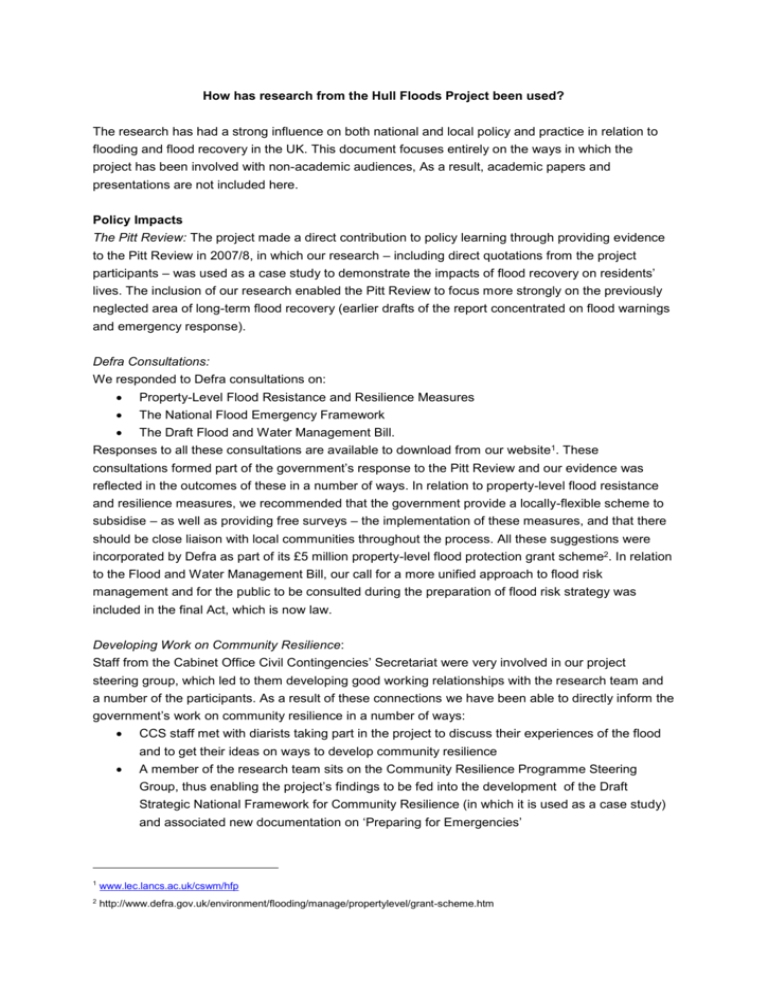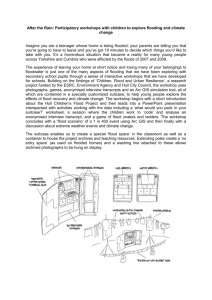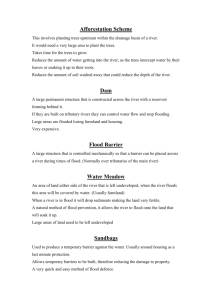How has research from the Hull Floods Project been used? The
advertisement

How has research from the Hull Floods Project been used? The research has had a strong influence on both national and local policy and practice in relation to flooding and flood recovery in the UK. This document focuses entirely on the ways in which the project has been involved with non-academic audiences, As a result, academic papers and presentations are not included here. Policy Impacts The Pitt Review: The project made a direct contribution to policy learning through providing evidence to the Pitt Review in 2007/8, in which our research – including direct quotations from the project participants – was used as a case study to demonstrate the impacts of flood recovery on residents’ lives. The inclusion of our research enabled the Pitt Review to focus more strongly on the previously neglected area of long-term flood recovery (earlier drafts of the report concentrated on flood warnings and emergency response). Defra Consultations: We responded to Defra consultations on: Property-Level Flood Resistance and Resilience Measures The National Flood Emergency Framework The Draft Flood and Water Management Bill. Responses to all these consultations are available to download from our website1. These consultations formed part of the government’s response to the Pitt Review and our evidence was reflected in the outcomes of these in a number of ways. In relation to property-level flood resistance and resilience measures, we recommended that the government provide a locally-flexible scheme to subsidise – as well as providing free surveys – the implementation of these measures, and that there should be close liaison with local communities throughout the process. All these suggestions were incorporated by Defra as part of its £5 million property-level flood protection grant scheme2. In relation to the Flood and Water Management Bill, our call for a more unified approach to flood risk management and for the public to be consulted during the preparation of flood risk strategy was included in the final Act, which is now law. Developing Work on Community Resilience: Staff from the Cabinet Office Civil Contingencies’ Secretariat were very involved in our project steering group, which led to them developing good working relationships with the research team and a number of the participants. As a result of these connections we have been able to directly inform the government’s work on community resilience in a number of ways: CCS staff met with diarists taking part in the project to discuss their experiences of the flood and to get their ideas on ways to develop community resilience A member of the research team sits on the Community Resilience Programme Steering Group, thus enabling the project’s findings to be fed into the development of the Draft Strategic National Framework for Community Resilience (in which it is used as a case study) and associated new documentation on ‘Preparing for Emergencies’ 1 www.lec.lancs.ac.uk/cswm/hfp 2 http://www.defra.gov.uk/environment/flooding/manage/propertylevel/grant-scheme.htm A small group of diarists from the project have set up as independent flood consultants3. They have presented (both alone, and with researchers from the project) at a number of CCS events, including to civil servants from the USA, Australia and Europe as part of the Multilateral Group on Community Resilience Policy Development. The CCS also used our research as a case study whilst on a visit to colleagues in the United States civil service. Our project was promoted as an example of how academia can be used to help policy making. Work on recovery and emergency preparedness: Relationships with the CCS have also enabled us to contribute to other areas of government policy: Diarists from the project presented to policy makers and practitioners at a CCS workshop on ‘Warning and Informing’ The project team have presented findings to the Cabinet Office Recovery Capability Board A new project4 has been launched using money from the Cabinet Office and the Economic and Physical Sciences Research Council to enable lessons from the research to be used to improve policy and practice around disaster recovery. As part of the project, the research team will review and refresh the National Recovery Guidance (to ensure that learning from the project is incorporated into this), develop new topic sheets and materials for courses at the Emergency Planning College, and refine and make available ‘Flood Snakes and Ladders’ – an interactive flood recovery simulation tool that has been developed using materials from the project. The game can be used at training events for emergency managers and policy makers to allow them to experience the complex and protracted nature of recovery. A pilot version of Flood Snakes and Ladders has already been used by the CCS as part of an internal staff ‘away day’. The feedback we experienced from this was very positive (see box below) Reaching out to policy and practice – feedback from stakeholders Speaking about the impact of the project on their work, one senior civil servant said: “The thing for me is to hear the real people on the ground, who were involved in the emergency, what happened, how did it affect them, what sort of things could have been better? I think at national level … there are lots of bits of government that actually don’t consult that much with people on the ground and what you end up with is a policy that’s good for an ivory tower in Whitehall but is actually useless for real people trying to deliver it on the ground. So I think the value of projects like this is that it enables the people writing the policy to talk to the people on the ground, to hear how it really was for them, rather than how they think it might have been” We also received the following feedback from a CCS colleague who used our ‘Flood Snakes and Ladders’ game at a training event: “I think the quotes really demonstrated to them [fellow CCS staff] the real impact on the ground and got many of them to be quite reflective as a result… While playing the game, we had moments… 3 For more information contact Jacky and Gordon Dixon on 01482 501080, Mobile: 07837420284 and Sandy and Paul Henderson 01482 827894, Mobile: 07738018924 4 ‘Recovering from Emergencies - knowledge transfer from Hull Research Project’, Jan-Mar 2011 using £4,566 EPSRC Pathways to Impact funding and £10,000 from the Cabinet Office where one player… just couldn't break out of a series of squares – they found this quite frustrating – the fact that they found even just 'playing' it like this frustrating was a brilliant way to demonstrate how exceptionally frustrating it would be if it happened in real life.” Evidence from the project is already being used in teaching at the Emergency Planning College, as one course-leader commented after attending our final project workshop: “I do use some of the quotes and stories I heard in my teaching. There’ve been a few examples of being able to contextualise theoretical policy discussions with real life examples in the training. And I think that’s why I went, to try and get some real live up-to-date examples of real people who have gone through something. You know, how do you make these things real to people? The only way to do that is to quote real people” Working with practitioners The project had a large steering group with representatives from a wide range of local, regional and national organizations5. These organisations were able to shape the conduct and focus of the research as well as use the findings to inform their work. For example, the Environment Agency (EA), who co-funded the project, have used the findings to develop an internal policy on flood recovery. One EA employee said: “Since we adopt an evidencebased approach to policy, research such as this is essential to our work. In particular there is an increasing recognition in Flood and Coastal Risk Management of the need to consider not only the economic but also the environmental and social impacts of both flooding itself and FCRM work that we do (this is reflected in several high level policy/strategy documents) – so we need social science research to provide us with evidence on these social impacts.” Other examples at the national level include our work with the British Damage Management Association and the insurance industry. The project team presented at the BDMA’s 2009 annual conference and this resulted in us running a ‘Masterclass’ training event for damage management practitioners. The ‘Masterclass’ focused on improving the experiences of recovery for flooded residents, using training materials developed from the project. Through a contact at the Association of British Insurers, a meeting was also arranged to allow the research team to discuss the project findings with a number of senior claims staff from leading insurance companies and the Chartered Institute of Loss Adjusters (CILA). The project’s final report and recommendations are now published on the CILA website 6. Finally, as outlined earlier, a number of the diarists from the project have established themselves as independent flood consultants and have spoken at a number events, including a televised broadcast from the National Flood Forum Annual Conference 2010, which was attended by leading stakeholders, including the Chair of the Environment Agency and MPs from all the major parties. 5 The project steering group included: Association of British Insurers, Humber Primary Care Trust, Cabinet Office, JBA Consulting, Middlesex University, Environment Agency, National Flood Forum, Hull City Council, North Bank Forum, Hull Community and Voluntary Services, University of Cumbria, Hull Residents and Tenants Association, Yorkshire and Humber Neighbourhood Resource Centre. A project participant also sat on the steering group. 6 http://www.cila.co.uk/news-events Local level impacts: There have also been impacts at the local level through a number of avenues. Following the devastating Cumbria Floods in November 2009, we were called in to work with Cumbria County Council’s Welfare Recovery Group to help inform the recovery process. This process started with a meeting where we were able to outline the findings of our study and answer questions on the recovery issues being faced by frontline staff. We then obtained additional funding from the ESRC and NERC to run a workshop for Cumbria which brought together social and physical scientists with stakeholders and community members to discuss the lessons from post 2007 flood research and to look at the contribution which research could make to flood recovery in the future. The workshop was held at Rheged, Penrith and was preceded by a number of smaller scale community events with funding from Age Concern and the National Institute for Health Research (NIHR) Research Design Service North West. Information and presentations from the day are available on our project website. Other examples of impact at the local level include presentations at flood awareness seminars held by the Association of Greater Manchester Authorities in November and December 2009. These resulted in Greater Manchester Resilience Forum’s flood planning being amended to reflect the study’s findings – for example, with a greater focus on the importance of the insurance industry in shaping residents’ experiences of flood recovery. We have also run training workshops for local authority emergency planners at the Local Government Association Emergency Planning Conference. Finally, in the North East, the Yorkshire and Humber Neighbourhood Resource Centre used the project as a case study of empowerment of local people7. Media engagement The project has been extensively covered in the wider media with the project team being interviewed on Radio 4 You and Yours and BBC Look North. The project has also received coverage on BBC Radio Humberside, Gloucestershire and Cumbria, as well as in the Guardian, the Times online and in a number of local papers. (See full details below) The Hull Children’s Flood Project A key finding from our research was that children and young people were being ignored. We were therefore successful in obtaining funding to develop a ‘sister’ project, looking at children and young people’s experiences of flood recovery in Hull. Findings from this project have also had a strong influence on policy and practice and full details will be made available on the Children’s Project website. Full Record of Reports, Workshops and Presentations Reports and consultation responses: Whittle, R., Medd, W., Deeming, H., Kashefi, E., Mort, M., Twigger Ross, C., Walker, G., Watson, N. (2010) “After the Rain – learning the lessons from flood recovery in Hull”, final project report for ‘Flood, Vulnerability and Urban Resilience: a real-time study of local recovery following the floods of June 2007 in Hull’, Lancaster University, Lancaster UK 7 http://goodwintrust.org/uploads/documents/493_01.pdf Sims8, R., Medd, W., Mort, M., Twigger-Ross, C., Watson, N., Walker, G. (2009) “Locally appropriate response and recovery – response to Defra consultation on the National Flood Emergency Framework” Lancaster UK, Lancaster University Sims, R., Medd, W., Mort, M., Twigger-Ross, C., Watson, N., Walker, G. (2008) “Perspectives on resilience from households in Hull – response to Defra consultation on policy options for promoting property-level flood protection and resilience” Lancaster UK, Lancaster University. Sims, R., Medd, W., Kashefi, E., Mort, M., Watson, N., Walker, G. & Twigger-Ross, C. (2008) “The ongoing experience of recovery for households in Hull – response to the Pitt Review Interim Report Learning the lessons from the 2007 floods, Chapter 9” Lancaster, UK Lancaster University. Sims, R., Medd, W., Kashefi, E., Mort, M., Watson, N., Walker, G. & Twigger-Ross, C. (2008) “A Case Study to support these concerns Handling personal property - findings from Hull”, chapter in Easthope, L. “The Human Aspects of Flooding: Personal Effects”, invited submission to the Pitt Review, University of Hertfordshire, March 2008 Organised workshops: 2010 “After the Rain has Gone” – a NERC/ESRC funded-workshop for community members, stakeholders and physical and social science researchers to look at flood recovery and future research issues following the floods of November 2009 in Cumbria. Developed in tandem with National Institute for Health Research North West Research Design Service, Cumbria County Council & Cumbria PCT, Penrith, March 24, 2010. 2009 “After the Rain”, Final project workshop, Hull Truck Theatre, Hull, June 25, 2009. Presentations at Stakeholder Events: Whittle, R. “Learning from the Experiences of Flooding”, Presentation to Civil Contingencies Secretariat International Civil Service Exchange Programme, Whitehall, London, November 4, 2010 Whittle, R. “From Hull to Cumbria 2009: How did we get here?” Workshop with flooded residents in Cumbria, Workington, March 17, 2010 Whittle, R. “Learning from the experiences of flooding”, National Flood Forum Annual Conference, Birmingham, February 25, 2010. Whittle, R. “Lessons from the 2007 Hull Flood Recovery”, Presentation to Association of Greater Manchester Authorities Flood Planning Awareness Session, Manchester, December 11, 2009. Whittle, R. “The customer experience: Feedback from Hull”, Presentation at British Damage Management Association Annual Convention, Warwickshire, December 2, 2009. Whittle, R. “Lessons from the 2007 Hull Flood Recovery”, Presentation to Association of Greater Manchester Authorities Flood Awareness Raising Session, Manchester, November 28, 2009. Medd, W. and Sims, R. “Learning the lessons for resilience – linking the everyday experience of flood recovery work with local and national policy learning”, Flood and Coastal Management Conference 2009, Telford, July 1, 2009. 8 Now Whittle Sims, R. “Flood, vulnerability and urban resilience: a real-time study of local recovery following the floods of June 2007 in Hull”, presentation given to Cabinet Office Recovery Capability Board, June 3, 2009. Sims, R. and Medd, W. “Flood, vulnerability and urban resilience: a real-time study of local recovery following the floods of June 2007 in Hull”, Charted Institute of Water and Environmental Management Annual Conference, London, April 29, 2009. Sims, R.“Flood survivors” Emergency Planning Society Human Aspects Group Seminar, Leicester, April 28, 2009. Sims, R., Medd, W. “Managing cowboys, dwelling in caravans: Life after flooding in Hull” Workshop at the Local Government Association Emergency Planning Conference, Leeds, February 3, 2009. Sims, R. and Medd, W. “Flood, vulnerability and urban resilience: a real-time study of local recovery following the floods of June 2007 in Hull”, Regional Workshop of Rotherham and Doncaster Mental Health Trust, Doncaster, December 7, 2007. Meetings with stakeholder groups: Regular steering group meetings for the Cabinet Office Community Resilience Programme to provide feedback on national policy documents. Invited to attend discussions at Civil Contingencies Secretariat ‘Warning and Informing’ workshop, Easingwold, Yorkshire, September 1 &2, 2010. Invited to attend Community Resilience meeting with a USA civil service visitor, London, May 25, 2010. Meeting with senior insurance claims representatives to discuss findings from Hull Research. Hosted by Association of British Insurers. London, February 23, 2010. Meeting with Cumbria Primary Care Trust to discuss recovery issues for Cumbrian Floods and future research development. Kendal, January 25, 2010. Meeting with Cumbria County Council Welfare Recovery Group to discuss recovery issues for Cumbria Floods, Penrith, December 15, 2009. Meeting with Lincolnshire County Council emergency planners to discuss research findings, July 16, 2009. Workshops and training events with and for stakeholders: See the ‘After the Rain’ events in Hull and Cumbria described previously. A ‘Masterclass’ training event was also held for the British Damage Management Association at Lancaster University on November 30, 2010 and for Greater Manchester Authorities as part of Exercise Trident on July 14, 2010.








